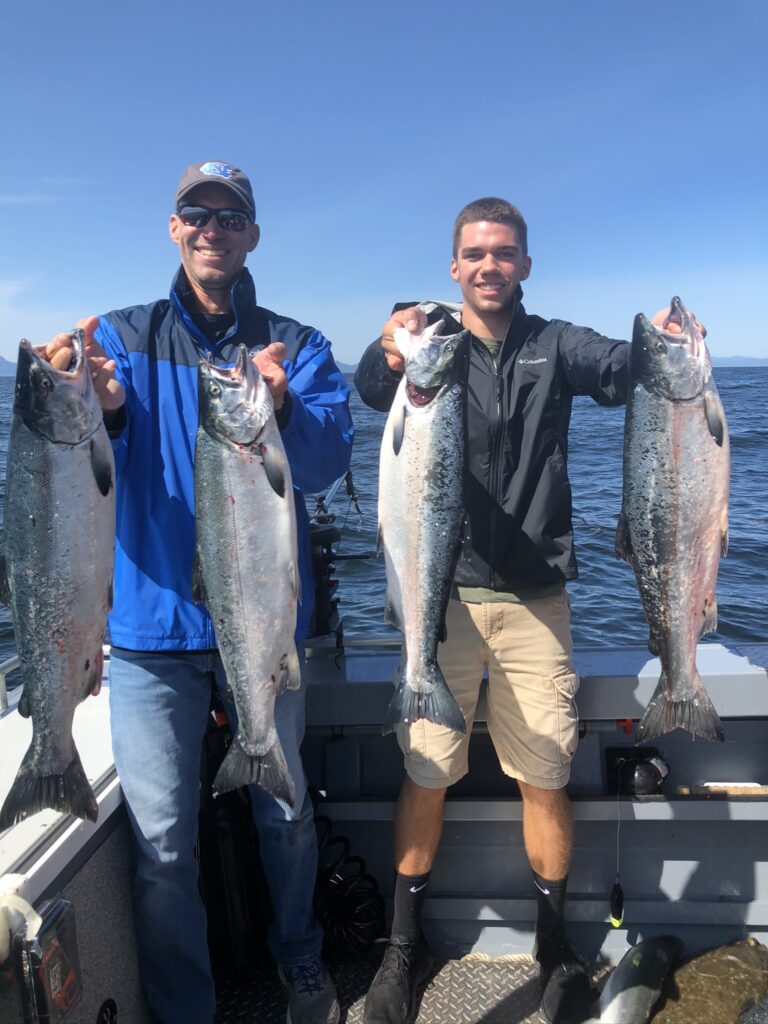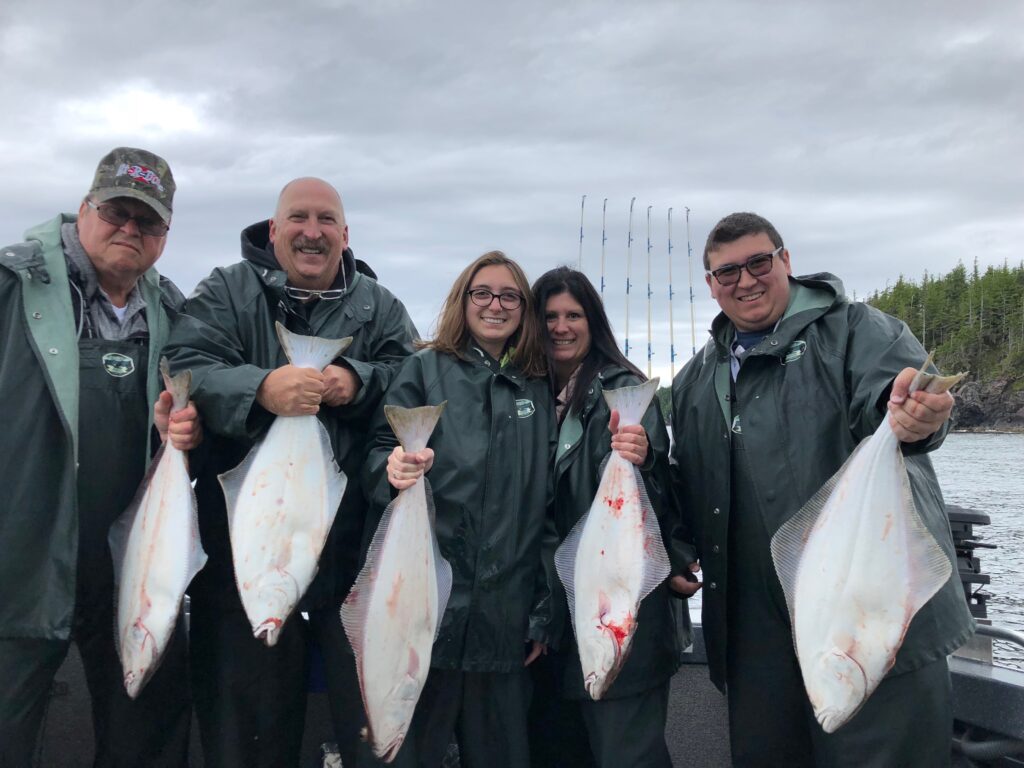The best way to go fishing in Ketchikan, Alaska is by boat. This is because the richest fishing grounds for salmon and halibut are only accessible via the waterways. While there is an opportunity to fish from the shore for salmon and trout, it’s not near as productive as fishing from a boat.
The best way to go fishing in Ketchikan is by choosing a reputable charter fishing consider when contacting charter operators. Ketchikan’s Finest Fishing Charters is revered by most as the premiere guide service in Ketchikan. Boasting outstanding reviews based on captains, equipment and overall experience.
Ketchikan Halibut Fishing
Halibut fishing occurs by bottom fishing or jigging on sandy flats in 200-400 feet of water. Presenting a variety of lures and cut bait near or on the bottom provides the best results. Halibut take time to get the bait in their mouths, so make sure to be patient before you reel tight on each halibut bite.
Contrary to bait, jig fishing allows an angler to work the lure emphatically bouncing it off the bottom. When the halibut or cod strike a jig it’s an immediate reaction strike and you can reel as soon as you feel pressure. While fishing for halibut in Ketchikan, Alaska, one can expect to catch pacific cod, rockfish, rays and even sharks.
Salmon Fishing In Ketchikan
Fishing for salmon in Ketchikan equates to trolling with downriggers, jigging or even mooching. The most common practice for catching salmon in Alaska is by trolling. We’ll discuss the various techniques below.
Trolling For Salmon
Trolling involves setting up multiple rods in combination with electric downriggers. The downriggers provide the capability to adjust the depth you are trolling each lure or bait combination. Once a salmon strikes the rods, it’s up to the angler to retrieve the line keeping constant tension. This is imperative for fighting salmon to the boat. Due to the fact that any slack will increase the probability the fish could shake the hook.
Salmon Mooching
Mooching is the most common technique when the salmon are in tight schools. This technique thrives in those conditions. Based on the fact that the boats positioning over the salmon and each angler will drop a cut plug herring directly over the school of salmon. The goal of mooching is to present the bait in front of the fish slowly. So anglers will repeatedly descend and retrieve their bait until a salmon strikes.
Salmon Jigging
Lastly, jigging for salmon comes with a high intensity approach. Jigging consists of positioning the boat over schools of salmon and using metal jigs or flies worked vertically through the water column. By doing so this imitates wounded or fleeing baitfish and triggers a strike. The best part of jigging for salmon is the fight on light tackle equipment.

Ketchikan Fishing Spots
Below we’ll go over a key of where the best fishing spots in Ketchikan are located. While each day typically offers up varying conditions. In turn, changes in terms of where the fish are most numerous. This key will give you an understanding of the most widely known and accessible areas.
Clover Pass is located on the northern end of the island and is best known for world class salmon fishing. Accessible by way of Clover Pass boat ramps, this area is typically busy with charter boats and recreational anglers.
Gravina Island is directly across from Ketchikan. Gravina hosts numerous spots for halibut fishing and salmon, as well as shrimping and crabbing.
Carroll Inlet lies about 6 miles from downtown Ketchikan. Carroll Inlet is best known for the world class salmon fishing, especially for king salmon.
Clarence Strait is the waterway between Gravina Island and Prince Of Whales. Clarence Strait is susceptible to weather conditions which makes it less available during certain periods of wind and wave heights. But when you can fish Clarence Strait it has amazing fishing for halibut, salmon and rockfish.
Mountain Point is the closest salmon fishing area to downtown Ketchikan. Only a ten to fifteen minute boat ride from local cruise ship docks makes this area extremely popular for charter boats and local anglers alike.
Herring Cove hosts a salmon hatchery that keeps this place alive with life. Each year the returning salmon head to Herring Cove, making it a top fishing destination for king salmon and silver salmon.
George Inlet is best known for crabbing and shrimping along with salmon fishing. Nestled in the fjords is where you’ll find George Inlet waterway. It comprises various islands, bays and estuaries.
When To Go Fishing In Ketchikan
The best time to fish in Ketchikan is anytime! That’s because there is always something to catch in these vibrant waters. However, the absolute best fishing in Ketchikan occurs during the months of June, July, August and September. During these months the salmon return to spawn and this also coincides with massive bait congregations. The giant schools of baitfish host the opportunity for halibut, whales, birds and all creatures swimming amongst the rich waters.
When To Go Salmon Fishing In Ketchikan
Salmon fishing in Ketchikan is best from June through September. King salmon arrive first and this marks the beginning of the salmon run. Following the king salmon in July are the silver salmon, pink salmon, chum salmon and sockeye salmon. Each run varies from year to year with some being more productive than others. Furthermore, these wild salmon runs are susceptible to multiple conditions such as weather, water temperature and river levels.
When To Go Halibut Fishing In Ketchikan
Fishing for halibut in Ketchikan is best from May through September. These are the peak months to catch trophy halibut in local waters. Halibut spend these months feeding on the abundance of food concentrated on underwater seamounts and sand flats. The best halibut fishing occurs in waters ranging from 200-400 feet.
Do I Need A License To Go Fishing In Ketchikan
Yes, you need a license to fish in Ketchikan. Based on what species you are fishing for will dictate what type of license you may need. For example, a general fishing license grants you the opportunity to catch halibut, rockfish, crabs and four species of salmon. However, if you are pursuing catching a king salmon, then you’ll need to purchase the additional king salmon stamp. The king salmon stamp goes along with your standard fishing license, meaning you can’t have one without the other. Lastly, for anyone involved in shrimping you’ll need the shrimp permit. These can all be obtained on The Alaska Fish And Game website.

